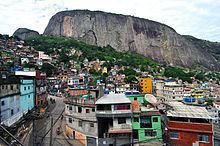Administrative Region Rocinha | Zone South Zone Population 69,356 (2010) | |
 | ||
Good morning rocinha witness
Rocinha (little farm) is the largest favela in Brazil, and is located in Rio de Janeiro's South Zone between the districts of São Conrado and Gávea. Rocinha is built on a steep hillside overlooking Rio de Janeiro, and is located about one kilometre from a nearby beach. Most of the favela is on a very steep hill, with many trees surrounding it. Almost 70,000 (census 2010) people live in Rocinha, making it the most populous favela in Brazil.
Contents
- Good morning rocinha witness
- Map of Rocinha Rio de Janeiro State of Rio de Janeiro Brazil
- favela tour in rocinha in rio de janeiro
- Community
- 2011 police and military operation
- Size
- In literature film and music
- In mass media and popular culture
- References
Map of Rocinha, Rio de Janeiro - State of Rio de Janeiro, Brazil
Although Rocinha is officially classified as a neighbourhood, many still refer to it as a favela. It developed from a shanty town into an urbanized slum. Today, almost all the houses in Rocinha are made from concrete and brick. Some buildings are three and four stories tall and almost all houses have basic sanitation, plumbing, and electricity. Compared to simple shanty towns or slums, Rocinha has a better developed infrastructure and hundreds of businesses such as banks, medicine stores, bus lines, cable television, including locally based channel TV ROC (TV Rocinha), and, at one time, a McDonald's franchise. These factors help classify Rocinha as a favela bairro, or favela neighborhood.
favela tour in rocinha in rio de janeiro
Community
There are a number of community organizations at work in Rocinha, including three neighbourhood associations and numerous NGOs and non-profit educational institutions.
Rocinha is home to most of the service workers in Zona Sul (the South Zone of Rio). Within Rocinha there are numerous NGO's staffed by both Brazilian and foreign teachers, volunteers and workers.
2011 police and military operation
In November 2011, a security operation was undertaken where hundreds of police and military patrolled the streets of Rocinha to crack down on rampant drug dealers and bring government control to the neighbourhood.
Size
Rocinha is the largest favela in Brazil and one of the most developed. Rocinha's population was estimated at between 150,000 and 300,000 inhabitants during the 2000s; but the IBGE Census of 2010 counted only 69,161 people.
In literature, film and music
Robert Neuwirth discusses Rocinha in his book entitled Shadow Cities. Rio de Janeiro was made the setting for the animation film Rio, where many scenes take place in Rocinha.
In 1998, Philip Glass wrote an orchestral piece titled "Days and Nights in Rocinha". It was meant as a reference to Ravels Bolero, written for Dennis Russell Davies, to thank him for putting Glass' works on stage. He was inspired by dance music that he heard during the carnival, resulting in a samba-like rhythmical structure with a lot of time signature changes and varieties, such as 14/8, 15/8 and 9/8+4/4.
In mass media and popular culture
Many celebrities have visited Rocinha, including Mikhail Gorbachev (during the Earth Summit of 1992) and actor Christopher Lambert. Some episodes of the Brazilian television series Cidade dos Homens (City of Men) were filmed there.
The 2008 film The Incredible Hulk featured aerial footage of Rocinha, showing the large number of intermodal containers repurposed as housing. It was also featured in the 2011 film Fast Five.
In the 2009 video game Call of Duty: Modern Warfare 2, there is a multiplayer map called "Favela". The location is said to be in Rio de Janeiro and it closely resembles Rocinha.
In the 2015 first-person shooter game Call of Duty: Black Ops III, Rocinha is referenced as the hometown of the specialist Outrider.
